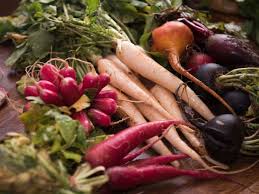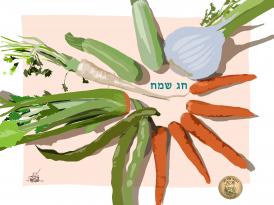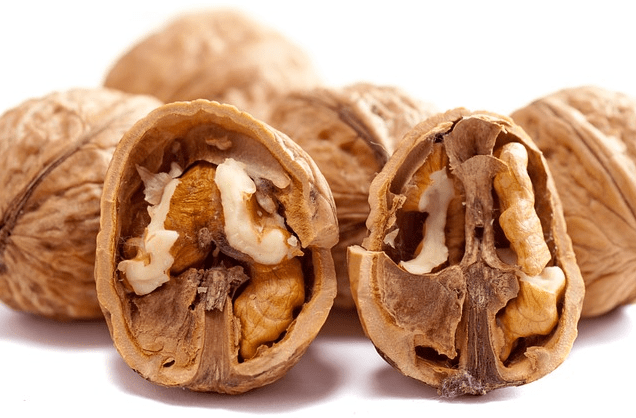There are some phrases that mind boggling to me. Especially in Hebrew. Why is a "pea brain" an insult?
Each pea is unique and tasty. Maybe a "pea brain" should be someone who thinks out of the pod? The Hebrew equivalent is "Cabbage head". But cabbage has lots of layers. Maybe "cabbage head" should actually be one who thinks in a complex manner, with multiple inner levels of understanding?
The radish also suffers from an unfavorable reputation (in Hebrew, at least) in terms of the expression – "Dry as a radish" which doesn't sound flattering at all. Who said radish is dry, or boring? The opposite is true. It is both spicy and tingly on the tongue, and also comes in a variety of shapes and colors and sizes – elongated and round, small and large, pinkish, purple, white and red. There are radishes that are green, yellow, and even black on the outside and white on the inside, or greenish on the outside and purple-pink on the inside!
The round shape and the reddish-purple color are more characteristic of European radishes (where the weather is very suitable for the cold-loving-radish) and is among the more modern versions of this vegetable, approximately since the 16thcentury. Older versions, such as those mentioned in the Greek and Roman scriptures, or in the pyramid murals of our Egyptian neighbors, and even in ancient Jewish scriptures which describe a longer radish, similar in shape to the varieties grown in the eastern region. In all countries, from China in the east to the Mediterranean basin in our region, the radish is considered an important and liked vegetable: it is never absent from the table of important rulers and public figures during both winter and summer: ("לא פסק משולחנם (של רבי ושל קיסר) לא צנון ולא חזרת ולא קישואים לא בימות החמה ולא בימות הגשמים" (בבלי, ברכות מ "א ").
Besides the crunchy vegetable served at the table, the radish was also used to produce oil (from the seeds), and the eastern peoples, known for their wisdom in combining different foods as a means of healing and treatment (May your foods be your medicine!), recommended using daikon, the local version of radish (literally translated into – "Big root") to relieve the stomach after a heavy meal and freshen the mouth. You are probably familiar with the recommendation to eat a slice of preserved radish or daikon, or their cousin, the ginger, between the pieces of sushi to refresh the sensitivity of the taste buds. Generally speaking, in Japan, they are very fond of daikon and it is their national vegetable, something almost parallel to Sabres for us.
Hebrew sources recommend the radish to ease the symptoms of a cold, and also to freshen the mouth.
It is speculated that the radish and daikon (rich in vitamin C) are also good as a preventative medicine for colds, and even for treating hangovers…
The radish is easy to grow, and grows beautifully in our local climate. It prefers sunny, humid, and fairly ordinary soil. If you wish to grow in your home garden something to put in a salad, or even in large enough pots, radish is a great choice, as it grows quickly and doesn't take up much space. It is very exciting to see small mounds of radish begin to peep from underground as it gets ready for harvest…
The leaves too are worthy and should be eaten – especially those of delicate radishes. In order to soften the stinging taste of the radish and daikon, you could peel them. To store them longer, you should separate the leaves from the radish and keep in a closed container in the fridge (if it does come out of the fridge looking tired and wilted after all, a quick bath in ice water will restore its perkiness and crunchiness).
If all this didn't make you want to run out and eat (and plant) radishes – you can always use it for artistic purposes…
Yours,
Maggie's Garden Team
Forecast:
In the ORGANIC vegetable baskets we expect (draft only):
Cucumber
Tomato
Lettuce
Potato
Eggplant
Barhi Dates
Parsley
Bוutternut Squash
Swiss chard
Sweet potatoe
The LARGE organic vegetable baskets also include:
Beet
Coriander
Pepper
In the ORGANIC fruit baskets:
Clementine
Orange
Banana
The large ORGANIC fruit baskets also include:
Sweetie
Red pomelo
New! New! The ORGANIC Green Basket:
Swiss chard
Celery
Spinach
Argula
Dill
A kind of lettuce
Mint
Sprouts
Kale












